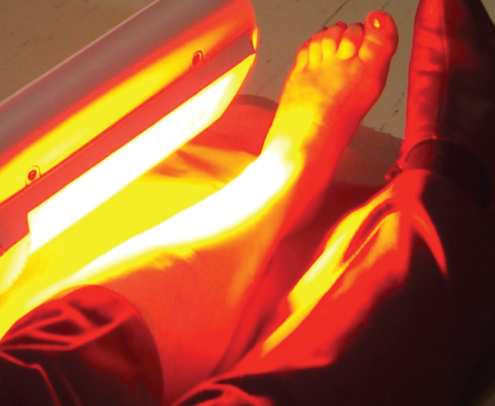Feature
The Wee Discovery Book of PDT
Published on 9 May 2021
With major contributions from staff at the Photobiology Unit, illustrations by Dundee’s Jim Glen (The Beano, The Dandy), and accompanying clinical images, the Wee Book provides an accessible overview of PDT, how it works and what it is used for.

Photodynamic therapy (PDT) is a treatment routinely carried out at the Photobiology Unit at NHS Tayside, and an active area of research in collaboration with the University of Dundee. PDT is commonly used for the treatment of non-melanoma skin cancers, most often the result of chronic exposure to UV radiation, though PDT also find application in other types of cancer. Understanding the treatment is important, both for patients and clinicians, in order to maximise effectiveness and engagement with the treatment.
While researching patient experiences with PDT, Dr Luke McLellan (formerly of The University of Dundee) identified a gap in the information offered to patients. There was very little information in the space between academic papers and NHS patient information leaflets – for those who want to delve a little deeper with the information still accessible. Thus, the Wee Discovery Book of PDT was born.
With major contributions from staff at the Photobiology Unit, illustrations by Dundee’s Jim Glen (The Beano, The Dandy), and accompanying clinical images, the Wee Book provides an accessible overview of PDT, how it works and what it is used for.
The Wee Book begins by talking about the skin and how UV radiation can damage skin cells, causing mutations and ultimately skin cancer. Different types of skin cancer are discussed with real example clinical photographs.
Treatments for non-melanoma skin cancers are then introduced, before focusing on PDT. The mechanisms of PDT are explained with illustrations helping to explain how the interaction of the three main parameters facilitate PDT: the drug, light and oxygen.

The process for delivering clinical PDT is then laid out, alongside the potential side effects, and how PDT can be used in other areas of the body, and not just the skin.
Creating the book collaboratively was an experience not too dissimilar from writing an academic paper, only the focus was slightly different. Instead of comments on axis labels, data sets or reference styles, instead we were discussing colour palettes, accessibility of the language, and what type of sunglasses the sun should have on. It was actually quite refreshing to be working in that hybrid sort of way, it felt much like a middle ground of academia and some of the science communication I am more used to – which was ultimately where the Wee Book was targeted.
I do feel that these types of science communication projects are important. Quite often the temptation is to simplify, and in doing so some of the finer details of the message may be lost. By supplementing simpler science communication with something that is, while accessible and understandable, more comprehensive, we can preserve the complexities that often make science so enticing in the first place.
The Wee Discovery Book of PDT is freely available from the University of Dundee here, and was funded by the Science and Technology Facilities Council.
About the author:
Dr Paul O’Mahoney is a Post-Doctoral Research Assistant working within the Photobiology Unit at Ninewells hospital. He obtained his PhD in Physics in 2015 and his BEng (Hons) in Mechanical Engineering in 2011, both from the University of Dundee.
His research is focused on the applications of physics in Photodynamic Therapy and Photodiagnosis.
Press Office, University of Dundee
press@dundee.ac.uk